Introduction
Yams are root crops from Africa and Asia that belong to the Dioscorea family, considered a traditional indigenous crop 1. Yams contains around 600 species with importance economically, such as Dioscorea oppositifolia, Thunb, Dioscorea rotundata Poir, Dioscorea dumetorum, Dioscorea esculenta, Dioscorea bulbifera, Dioscorea, cayenensis and Lamk Dioscorea alata, but only 12 species are edible 2.
The tubers of yam present diverse compositions that contribute to its function, which consists mainly of starch, sugars, protein, fibers, polysaccharides, polyphenols, flavonoids, and other ingredients 3. Moreover, fresh yam has a high moisture content with values between 50 and 80%, making it susceptible to deterioration and difficult to preserve.
Yams are one of the main stable foods in tropical country 4, and have considerable nutritional properties such as antioxidants, antidiarrheal, immune regulation, and anti-inflammatory abilities 5, becoming popular use in the diet due to their healthy function. Traditionally, yams are usually consumed in different forms resulting from any of the processes of fermentation, drying, boiling, roasting, milling, steaming, frying, and pounding 6. Therefore, the main product obtained from yam is the flour obtained by a dry and milled process assembling a food product for consumption that can be stored for several weeks; nevertheless, yam flour, in its native form, has limited use in the food production industry.
The process of fresh tuber transformation consists of the development of flour by peeling, slicing, blanching, and sun drying 7, therefore there is an urgent demand to modify the yam flour to improve its high perishability. The flours are used in food systems as ingredients or processing aids and can be consumed as a food ingredient in various forms, i.e. to develop instant pounded yam. The knowledge of physical and rheological properties is needed since these are frequently incorporated in the preparation of a wide range of tropical foods and for the design, development, sensory evaluation, and evaluation of the shelf-life stability estimation of the food product; however, rheological studies of Colombian hawthorn yamflour – CHYF are limited, so this investigation can increase its potential applications in the food industry. Therefore, the objective was to investigate the physicochemical, structural, and rheological properties of Colombian hawthorn yam flour (CHYF).
Materials and Methods
Materials
The size of the Colombian Hawthorn yamtubers (2 – 4 kg) was cultivated in the Department of Bolivar – Municipality, Carmen de Bolivar, Colombia, as shown in Figure 1. Acetic acid, sodium hydroxide, and phenolphthalein were obtained from Sigma–Aldrich (St. Louis, MO, USA). Hexane and ethanol were purchased from Panreac (Barcelona, Spain).
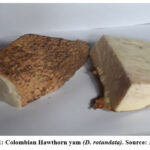 |
Figure 1: Colombian Hawthorn yam (D. rotundata). Source: Authors. |
Formulation of yam flour
Colombian Hawthorn yamtubers were cleaned to remove solid particles; after that were washed, peeled off, and sliced manually to a thickness of 10 mm with a manual stainless steel knife. Thin slices were air-dried in a crossflow at 50 °C for 24 h and pulverized using an IKA MF 10.2 (Germany). The obtained flour was packaged separately in transparent polypropylene bags, sealed, and stored at 5 °C.
Determination of Proximal Composition
Moisture, ash, protein, total fat, and carbohydrates of CHYF were obtained following the methods described in the Official Methods of Analysis – AOAC 8.
Fourier Transform-Infrared Spectroscopy (FTIR – ATR) Analysis
The characterization of flours was carried out employing Fourier transform infrared spectroscopy, Spectrum 400 model apparatus (Perkin Elmer). Operate in ATR mode to obtain the Fourier transform infrared (FTIR). A small sample was placed in the ATR, proved, and measured as they were. Spectra were obtained for a wavelength range of 500 – 4000 cm-1 at a resolution of 4 cm-1, in transmission mode.
Morphology analysis
The morphology of CHYF was studied by scanning electron microscopy (SEM) with an energy-dispersive X-ray spectrometer (SEM-FOT) EM-30AXn, (Coxem, Daejeron, Korea).
Rheological properties
Rheological characterization was done in CHYF at 10 %wt. in water employing a Rheometer Haake Mars 60 (Thermo Scientific, Germany) using a Peltier system and equipped with a cone plate geometry (1°; 35 mm diameter and 0.053 mm GAP). To have the same recent past thermal and mechanical history, the temperature was fixed, and each sample was equilibrated at 600 seconds before the rheological test.
Steady shear test: Viscous flow curves were performed from 10-3 at 103 s-1 at 25 ºC.
Stress test: A stress sweep from 10-3 to 103 Pa at 1 Hz, was carried out to determine the linear viscoelastic regime (LVR).
Frequency sweep: The frequency sweep test was performed from 10-2 to 102 rad·s1 at 25 ° C in the linear viscoelastic range.
Temperature sweep: Thermo-viscoelasticity properties were investigated at a ramp temperature of 20 to 80 °C, at a heating rate of 5 °C/min, and a constant frequency in the linear viscoelastic range.
Pasting properties: The sample was heated from 25 to 95 °C with a holding time of 2 min followed by cooling to 25 °C. The heating and cooling rate was at a constant rate of 5 °C/min.
Statistical Analysis
Significative treatments were determined using one-way analysis of variance ANOVA with Honestly Significant Difference (Tukey’s HSD) grouping at a 95% confidence level using Statgraphics Centurion XVI. All analyses were done in triplicate.
Results and Discussion
Proximate composition of CHYF
The proximate composition of CHYF is reported in Table 1. The flour has a high percentage of carbohydrates (80.47 ± 1.14%), followed by the protein content (8.76 ± 0.58%), ash (3.56 ± 0.52%), and the lowest fat content (0.39 ± 0.06%) indicating that the physicochemical and material properties of the flours vary considerably among the four species 9. The moisture content of CHYF was lower than 7%, improving the storage conditions and preventing spoilage 10,11 and longer shelf stability; the high-moisture products (>12%) usually have shorter shelf stability compared to lower moisture products (<12%) 12. Similar results were obtained by Setyawan et al. 13 for flour of Dioscorea esculenta and Dioscorea bulbifera with values of 5.62 and 6.72% dried by oven, by Ilesanmi et al., 14 for white yam (5.50%), and consistent with the safety requirement of the Codex Alimentarius Commission for wheat flour 15.
Table 1: Proximal composition of CHYF.
|
Dioscorea sp flours |
Moisture % |
Ash % |
CHO % |
Fat % |
Protein % |
References |
|
Colombian Hawthorn yam flour – CHYF |
4.82 ± 1.13b |
3.56 ± 0.52b |
80.47 ± 1.14a |
0.39 ± 0.06c |
8.76 ± 0.58c |
** |
|
White yam flour |
7.42 |
2.25 |
73.41 |
0.19 |
6.96 |
Yalindua et al., 16 |
|
Purple yam flour |
10.60 |
2.35 |
79.40 |
0.28 |
6.57 |
Yalindua et al., 16 |
|
Bitter yam (Dioscorea dumetorum) flour, white variety |
8.18 |
5.39 |
78.15 |
0.64 |
5.67 |
Oyeyinka et al., 9 |
|
Bitter yam (Dioscorea dumetorum) flour yellow variety |
7.94 |
5.07 |
77.74 |
0.74 |
6.18 |
Oyeyinka et al., 9 |
|
Chinese Yam (Dioscorea opposita Thunb.) Flour. Tai Nung No.2 |
5.39 |
4.30 |
83.02 |
0.30 |
11.1 |
Hsu et al., 17 |
|
Chinese Yam (Dioscorea opposita Thunb.) Flour, Ta Shan |
4.73 |
4.92 |
82.1 |
0.30 |
10.2 |
Hsu et al., 17 |
|
Chinese Yam (Dioscorea opposita Thunb.) Flour, Ming-Chien |
4.32 |
4.68 |
82.2 |
0.29 |
11.30 |
Hsu et al., 17 |
|
Chinese yam flours from expansion stage |
n.d. |
1.77 |
n.d. |
1.52 |
10.88 |
Zou et al., 18 |
|
Chinese yam flours from dormant stage |
n.d. |
1.13 |
n.d. |
3.23 |
9.12 |
Zou et al., 18 |
**Data determined by authors. Mean ± standard deviation. Different letters in the same file express statistically significant differences (p < 0.05)
CHO: Carbohydrate
n.d.: non-determinate, this may be attributed to the decreased water loss during the drying process
The proximal compositions of CHYF reveal that it could be used in food formulations as a source of carbohydrates; thus, it can be used as an alternative staple food to provide daily energy needs. Then, yams have been considered rich in resistant starch content and gluten-free, being a promising food source for people to reduce the risk of obesity, diabetes, wheat allergy, and the incidence of celiac disease 19. In addition, the consumption of diets containing glucose and fructose is higher than the consumption of other diets 20.
The protein content was moderate, higher than white, purple 16, and bitter yam 9 Chinese yam 17, which was an alternative to improve the techno-functional properties. Then, the yams present relatively low values improving the protein digestibility 20. Such differences between yam species may be related to their genetic origins and the geographic sources from which they were grown. Moreover, accessing these nutrients is an advantage for food sovereignty; considering the dietary seasonality is foundational to native foodways and the historical trade relationships for food products development associate the right of peoples to healthy and culturally appropriate food produced with Colombian Hawthorn yam through ecologically sound and sustainable methods.
To evaluate the functional groups of CHYF, the analysis by Fourier Transform Infrared Spectroscopy (FTIR) was done, providing unique insights into protein conformation change 21. Then, the FTIR spectra of CHYF are shown in Figure 2. The peaks 1335–1320 are a CH deformation from ring vibration associated with cellulose and polysaccharides, the peaks between 1630–1600 are COO– asymmetric stretching, peak COO− asymmetric stretching are CH2 bending mode, 1650–1580 are N–H bending vibration of primary amines, peaks between 1700–1600 corresponds to amide I absorption (predominantly the C=O stretching), between 1741 to 1740 correspond to C=O stretching of alkyl ester, C=O stretching of triglycerides 22 and at 3600 to 3200 cm−1 are smaller in the CHYF spectra, corresponding to O–H stretching attributed to moisture 23. Then, the low infrared spectroscopy suggests relatively open-structured and highly hydrated macromolecules.
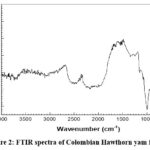 |
Figure 2: FTIR spectra of Colombian Hawthorn yam flour. |
Morphology
Figure 2 shows images at different scales (200, 500, 1000, and 2000X) of CHYF. The micrographs displayed flour particles have spherical/oval smooth surfaces and some particles present flat faces defined with an oval morphology (Figure 3). Larger clusters (like film on the particles) are visible as cellular material (Figures 3a, 3b, and 3c), associated with the starch and protein content in flour. Möller et al.24 reported similar results for the grinding of yellow peas and recognized the small round particles adhering to the surface of the starch granules as protein bodies, and Zhu et al., 25 associated this cluster with the starch and fiber content in mung bean flour.
Furthermore, the particle size of CHYF was analyzed (Figure 3d); the deviation is in the range of 27 to 43µm (<10%). Obtained results were lower than those reported for freeze-dried potato flour (56.51 to 307.53 µm) 26, roasted Highland Barley Flour (< 150 µm) 27, and amaranth flour (380 µm) 28. The structure and morphological characteristics of the flour granules are then affected by the origin, agronomy, and processing conditions of yams prominently due to the distinct characteristics and potential applications.
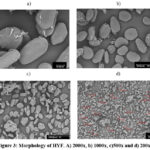 |
Figure 3: Morphology of HYF. A) 2000x, b) 1000x, c)500x and d) 200x. |
Rheological properties
The rheological properties of CHYF were evaluated in a steady and oscillatory state. Figure 4 presents the viscous flow behavior of flour, which shows a decrease in viscosity with the increase of shear rate, demonstrating a possible drop, the typical behavior of non-Newtonian fluid-type shear thinning 29, associated with the structural collapse of the molecules as a result of the hydrodynamic effect of the forces generated. Then, the Power-law model (Equation 1) allows one to describe many fluids containing soluble solids with high molecular weight:

where k is the consistency index and n is the flow index.
Then, the flow curves of CHYF could be adequately described by the Power law model due to the high determination coefficient (R2 > 0.99), presenting a consistency index of 518.52 31.79 and a flow index of 0.04 0.01. Then the flow behavior index of the suspensions was lower than 1 at all applied pressures, and this corrected for shear-thinning flow behavior.
The viscoelastic behavior of CHYF was analyzed in the linear viscoelasticity region (1 Pa). The evaluation of storage modulus () was higher than loss modulus () and Loss Tangent (Tan δ) was done (Figure 5a). were higher than the loss modulus with no signs of crossover in the frequency range studied exhibiting a solid-liquid behavior.
Figure 5b presents the behavior of the loss tangent (Tan δ) concerning frequency. CHYF present Tan δ lower than 0.5 indicates the relative contribution of the elastic and viscous components of flours 30; these values are comparable with the data reported by Kong et al., 31 for starch and flour of rice and Lu et al., 32 for composite starch gel.
The effect of temperature on and CHYF are shown in Figure 5c exposing the phase transitions and elasticity and allowing the selection of appropriate temperature ranges for the employee of flour for the development of food products. The flour presents a predominant solid-like behavior where was higher than in the range of temperature studied. The viscoelastic behavior of neither did change upon heating, nevertheless, increased from 50 ºC, preserving their solid-like properties. A gel point was not observed because high temperatures reduce the intermolecular hydrogen bonding interactions, removing energized water molecules surrounding the CHYF chains.
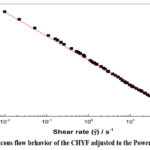 |
Figure 4: Viscous flow behavior of the CHYF adjusted to the Power Law model. |
Pasting properties
The pasting properties are important to determine the use of ingredients as a thickener and binder in the food industry and could affect the quality and end-use of CHYF. The viscosity of the gel formed is a major aspect of the decision on the use of flour in various applications. The pasting properties of CHYF at 10%w/w are shown in Figure 5d and Table 2, including peak viscosity (PV), trough viscosity (TV), breakdown viscosity (BV), setback viscosity (SB), final viscosity (FV), pasting temperature (PT) and time peak (TP). PT measures the temperature when the viscosity starts to rise and at the beginning of gelatinization; the PV indicates the maximum swelling of the flour granule before disintegration; the BV indicates the difference between the maximum and minimum viscosities at constant temperature (95 ºC) reflecting the stability of flour; the FV reflects the cold paste viscosities and the SB is indicative of the retrogradation tendency 33.
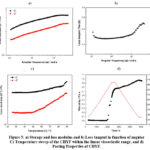 |
Figure 5: a) Storage and loss modulus and b) Loss tangent in function of angular C) Temperature sweep of the CHYF within the linear viscoelastic range, and d) Pasting Properties of CHYF. |
Table 2: Pasting parameter of CHYF.
|
Dioscorea sp flours |
PV cP |
TV cP |
BV cP |
SB cP |
FV cP |
PT ºC |
TP Min |
References |
|
Hawthorn yam Flour – CHYF |
750f |
620e |
130c |
330d |
950g |
81.6b |
30.93a |
** |
|
Bitter White yam |
1781.04 |
1355.56 |
384.50 |
902.40 |
2263.51 |
87.36 |
5.09 |
Oyeyinka et al., 9 |
|
Bitter Yellow yam |
1322.02 |
1058.23 |
264.40 |
596.50 |
1624.10 |
87.30 |
5.08 |
Oyeyinka et al., 9 |
|
Chinese yam flours |
3193 |
1560 |
1633 |
401 |
1961 |
88,10 |
3.93 |
Zou et al., 18 |
|
Chinese yam flours |
5135 |
2989 |
2146 |
1460 |
4449 |
94.49 |
4.40 |
Zou et al., 18 |
PV: Peak viscosity; TV: Trough viscosity; BV: Breakdown viscosity; SV: Setback viscosity; FV: Final viscosity; PT: Pasting temperature; TP: Time peak
**Data determined by authors. CV < 0.05. Different letters in the same file express statistically significant differences (p < 0.05)
Colombian Hawthorn yamflours showed a high PT value of 81.6 °C, associated with the presence of components, i.e., oligosaccharides, proteins, and cellulose. Other flours obtained similar results, such as yellow pea (79.3 ºC) 34 beans (80.7 – 84.1 ºC) 35 and kidney bean (89.4 – 94.9 ºC) 36, then small flour granules were found to exhibit greater resistance to rupture and loss of molecular order 37. The peak temperature in the pasting temperature records the highest temperature corresponding to the peak viscosity 38; in the case of hawthorn yamflours, the PV value is 0.75 Pa·s. BV was 0.13 Pa·s, measuring the difference between PV and the intermediate hot paste recorded during the holding stage; and it is related to gel stability, so lower values suggest that the four is more stable during cooking 39. SB shows how the viscosity of the flour suspension paste (0.62 Pa·s,) recovered during the cooling period and is calculated by the difference between FV and TV. The SB value is commonly used to reflect the retrogradation; hawthorn yamflours present an SV of 0.33 Pa·s. associated with the development of strong or weak gels in the heating-cooling process; the highest SB resulted in the development of strong rigid gels. An increase in the FV of the flour indicates its resistivity to shearing, resulting in a rigid gel, which might be attributed to the presence of proteins and soluble sugars; then the final viscosity of CHYF was 0.95 Pa·s.
Pasting properties of CHYF present similar values to bitter white and yellow yam 9 and Chinese yam flour 18. Then, the pasting parameters of the flours were attributed to the chemical composition and particle size that finely tuned the gel structure after the heating and cooling process.
Conclusion
Hawthorn yam flour presents a high percentage of carbohydrates and moderate by protein content, in comparison with different varieties of Disoscorea sp.; moreover, the chemical composition is associated with the content of polysaccharides and cellulose. The SEM images displayed flour particles with a range from 27 to 43µm, with spherical/oval morphology and a smooth surface with larger clusters as a cellular material associated with the starch and protein content in flour. Furthermore, flour at 10% wt in water presented a decrease of viscosity with the shear rate, a typical behavior of non-Newtonian flow behavior type shear thinning, with a high coefficient of correlation (R2 > 0.99) to the Power Law model. Their viscoelastic properties evidence the structure of strong gel (G’ > G”) when the pasting properties show the beginning of gelatinization at 81.6 ºC. In conclusion, Colombian Hawthorn yamflour presents considerable composition and appropriate rheological properties suitable for applications in the food industry as a thickening or gelling agent in aqueous solutions. As well as an important nutritional source for the food sovereignty of many countries where this tuber is grown.
Acknowledgement
The research was funded by Projects 142-2019 sponsored by the Universidad de Cartagena and Project No. 368-2019, code 110780864755 sponsored by MinCiencias (Colombia). The authors are grateful for their financial support.
Conflict of Interest
The author(s) declares no conflict of interest.
Funding Sources
The author(s) received no financial support for the research, authorship, and/or publication of this article.
References
- Chaïr H, Sardos J, Supply A, Mournet P, Malapa R, Lebot V. Plastid phylogenetics of Oceania yams (Dioscorea spp., Dioscoreaceae) reveals natural interspecific hybridization of the greater yam (D. alata). Botanical Journal of the Linnean Society. 2016;180(3):319-333. doi:10.1111/BOJ.12374
CrossRef - Vidal Tovar CR. El ñame espino (Dioscorea rotundata Poir.): una opción en la producción de jarabes edulcorantes intermedios para la industria alimentaria. Revista de Investigación Agraria y Ambiental. 2010;1(2):19. doi:10.22490/21456453.896
CrossRef - Chen X, Lu J, Li X, et al. Effect of blanching and drying temperatures on starch-related physicochemical properties, bioactive components, and antioxidant activities of yam flours. LWT – Food Science and Technology. 2017;82:303-310. doi:10.1016/J.LWT.2017.04.058
CrossRef - Omonigho SE, Ikenebomeh MJ. Effect of temperature treatment on the chemical composition of pounded white yam during storage. Food Chem. 2000;71:215-220. doi:10.1016/S0308-8146(00)00158-8
CrossRef - Chiu CS, Deng JS, Chang HY, et al. Antioxidant and anti-inflammatory properties of taiwanese yam (Dioscorea japonica Thunb. var. pseudojaponica (Hayata) Yamam.) and its reference compounds. Food Chem. 2013;141(2):1087-1096. doi:10.1016/J.FOODCHEM.2013.04.031
CrossRef - Odeku OA. Potentials of tropical starches as pharmaceutical excipients: A review. Starch – Stärke. 2013;65(1-2):89-106. doi:10.1002/STAR.201200076
CrossRef - Akissoe HN, Hounhouigan D, Bricas N, Vernier P, Nago CM, Olorunda OA. Physical, chemical and sensory evaluation of dried yam (Dioscorea rotundata) tubers, flour and ‘amala’ a flour derived product. Tropical Science, 2001, 41, 151-155. Tropical Science. 2001;41:151-155.
CrossRef - AOAC. Association of Official Analytical Chemist.; 1998.
CrossRef - Oyeyinka SA, Adeleke OF, Dauda AO, Abiodun OA, Kayode RMO, Adejuyitan JA. Flour composition and physicochemical properties of white and yellow bitter yam (Dioscorea dumetorum) starches. Ind Crops Prod. 2018;120:135-139. doi:10.1016/J.INDCROP.2018.04.061
CrossRef - Odeku OA, Picker-Freyer KM. Analysis of the Material and Tablet Formation Properties of four Dioscorea Starches. Starch – Stärke. 2007;59(9):430-444. doi:10.1002/STAR.200700619
CrossRef - Ihekoronye AI, Ngoddy PO. Integrated Food Science and Technology for the Tropics. Macmillan; 2013. Accessed May 18, 2022. https://agris.fao.org/agris-search/search.do?recordID=US201300674821
- Adegunwa MO, Adelekan EO, Adebowale AA, Bakare HA, Alamu EO. Evaluation of nutritional and functional properties of plantain (Musa paradisiaca L.) and tigernut (Cyperus esculentus L.) flour blends for food formulations. http://www.editorialmanager.com/cogentchem. 2017;3(1):1383707. doi:10.1080/23312009.2017.1383707
CrossRef - Setyawan N, Maninang JS, Suzuki S, Fujii Y. Variation in the Physical and Functional Properties of Yam (Dioscorea spp.) Flour Produced by Different Processing Techniques. Foods 2021, Vol 10, Page 1341. 2021;10(6):1341. doi:10.3390/FOODS10061341
CrossRef - Ilesanmi, Hussein, 1* JB, Filli KB. Carpathian journal of food science and technology impacts of pretreatments and drying techniques on the physiochemical, microbial, and sensory properties of white yam (Dioscorea Rotundata) FLOUR. Published online 2022. doi:10.34302/crpjfst/2022.14.4.13
CrossRef - Codex Stan 152 – 1985. Standard for wheat flour. Published 2019. Accessed September 3, 2023. Such differences between yam species may be related to their genetic origins and the geographic sources from which they were grown.
- Yalindua A, Manampiring N, Waworuntu F, Yalindua FY. Physico-chemical exploration of Yam Flour (Dioscorea alata L.) as a raw material for processed cookies. JPhCS. 2021;1968(1):012004. doi:10.1088/1742-6596/1968/1/012004
CrossRef - Hsu CL, Chen W, Weng YM, Tseng CY. Chemical composition, physical properties, and antioxidant activities of yam flours as affected by different drying methods. Food Chem. 2003;83(1):85-92. doi:10.1016/S0308-8146(03)00053-0
CrossRef - Zou J, Xu M, Zou Y, Yang B. Physicochemical properties and microstructure of Chinese yam (Dioscorea opposita Thunb.) flour. Food Hydrocoll. 2021;113:106448. doi:10.1016/J.FOODHYD.2020.106448
CrossRef - Kumoro AC, Widiyanti M, Ratnawati R, Retnowati DS. Nutritional and functional properties changes during facultative submerged fermentation of gadung (Dioscorea hispida Dennst) tuber flour using Lactobacillus plantarum. Heliyon. 2020;6(3):e03631. doi:10.1016/J.HELIYON.2020.E03631
CrossRef - Shirley RB, Parsons CM. Effect of ash content on protein quality of meat and bone meal. Poult Sci. 2001;80(5):626-632. doi:10.1093/PS/80.5.626
CrossRef - Guerrero P, Kerry JP, de La Caba K. FTIR characterization of protein–polysaccharide interactions in extruded blends. Carbohydr Polym. 2014;111:598-605. doi:10.1016/J.CARBPOL.2014.05.005
CrossRef - Kong J, Yu S. Fourier transform infrared spectroscopic analysis of protein secondary structures. Acta Biochim Biophys Sin (Shanghai). 2007;39(8):549-559. doi:10.1111/J.1745-7270.2007.00320.X
CrossRef - Barbosa LCA. Infrared spectroscopy: in the characterization of organic compounds. Minas Gerais. Published online 2007:189.
- Möller AC, van der Padt A, van der Goot AJ. From raw material to mildly refined ingredient – Linking structure to composition to understand fractionation processes. J Food Eng. 2021;291:110321. doi:10.1016/J.JFOODENG.2020.110321
CrossRef - Zhu HG, Wang Y, Cheng YQ, Li ZG, Tong LT. Optimization of the powder state to enhance the enrichment of functional mung bean protein concentrates obtained by dry separation. Powder Technol. 2020;373:681-688. doi:10.1016/J.POWTEC.2020.07.023
CrossRef - Buzera A, Gikundi E, Orina I, Sila D. Effect of Pretreatments and Drying Methods on Physical and Microstructural Properties of Potato Flour. Foods 2022, Vol 11, Page 507. 2022;11(4):507. doi:10.3390/FOODS11040507
CrossRef - Zhao Z, Ming J, Zhao G, Lei L. Color, Starch Digestibility, and In Vitro Fermentation of Roasted Highland Barley Flour with Different Fractions. Foods 2022, Vol 11, Page 287. 2022;11(3):287. doi:10.3390/FOODS11030287
CrossRef - Coţovanu I, Mironeasa S. Features of Bread Made from Different Amaranth Flour Fractions Partially Substituting Wheat Flour. Applied Sciences 2022, Vol 12, Page 897. 2022;12(2):897. doi:10.3390/APP12020897
CrossRef - Hardcover CWM, Macosko CW. Rheology: Principles, Measurements, and Applications ABOUT THE AUTHOR. Published online 1994. Accessed July 5, 2021. https://www.wiley.com/en-us
- Zhou P, Eid M, Xiong W, et al. Comparative study between cold and hot water extracted polysaccharides from Plantago ovata seed husk by using rheological methods. Food Hydrocoll. 2020;101:105465. doi:10.1016/J.FOODHYD.2019.105465
CrossRef - Kong X, Kasapis S, Bao J. Viscoelastic properties of starches and flours from two novel rice mutants induced by gamma irradiation. LWT – Food Science and Technology. 2015;60(1):578-582. doi:10.1016/j.lwt.2014.08.034
CrossRef - Lu ZH, Sasaki T, Li YY, Yoshihashi T, Li L te, Kohyama K. Effect of amylose content and rice type on dynamic viscoelasticity of a composite rice starch gel. Food Hydrocoll. 2009;23(7):1712-1719. doi:10.1016/j.foodhyd.2009.01.009
CrossRef - Li W, Wu G, Luo Q, et al. Effects of removal of surface proteins on physicochemical and structural properties of A- and B-starch isolated from normal and waxy wheat. J Food Sci Technol. 2016;53(6):2673-2685. doi:10.1007/S13197-016-2239-3
CrossRef - Waduge RN, Warkentin TD, Donner E, Cao R, Ramdath DD, Liu Q. Structure, Physicochemical Properties, and In Vitro Starch Digestibility of Yellow Pea Flour Modified with Different Organic Acids. Cereal Chem. 2017;94(1):142-150. doi:10.1094/CCHEM-03-16-0068-FI
CrossRef - Bento JAC, Morais DK, de Berse RS, Bassinello PZ, Caliari M, Soares Júnior MS. Functional, thermal, and pasting properties of cooked carioca bean (Phaseolus vulgaris L.) flours. Applied Food Research. 2022;2(1):100027. doi:10.1016/J.AFRES.2021.100027
CrossRef - Wani IA, Andrabi SN, Sogi DS, Hassan I. Comparative study of physicochemical and functional properties of flours from kidney bean (Phaseolus vulgaris L.) and green gram (Vigna radiata L.) cultivars grown in Indian temperate climate. Legume Science. 2020;2(1):e11. doi:10.1002/LEG3.11
CrossRef - Berry JW, Scheerens JC, Bemis WP. Buffalo Gourd Roots: Chemical Composition and Seasonal Changes in Starch Content. J Agric Food Chem. 1978;26(2):354-356. doi:10.1021/JF60216A022/ASSET/ JF60216A022.FP.PNG_V03
CrossRef - Ahmed J, Al-Jassar S, Thomas L. A comparison in rheological, thermal, and structural properties between Indian Basmati and Egyptian Giza rice flour dispersions as influenced by particle size. Food Hydrocoll. 2015;48:72-83. doi:10.1016/J.FOODHYD.2015.02.012
CrossRef - Zhang H, Meng Y, Liu X, Guan X, Huang K, Li S. Effect of extruded mung bean flour on dough rheology and quality of Chinese noodles. Cereal Chem. 2019;96(5):836-846. doi:10.1002/CCHE.10184
CrossRef

This work is licensed under a Creative Commons Attribution 4.0 International License.





